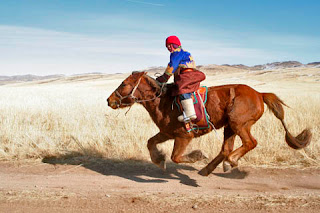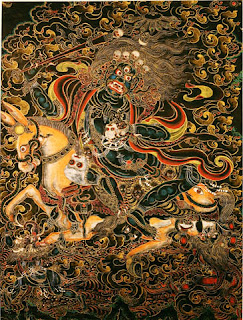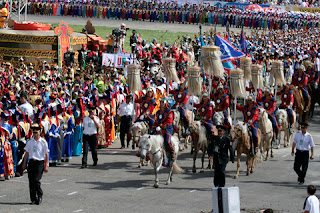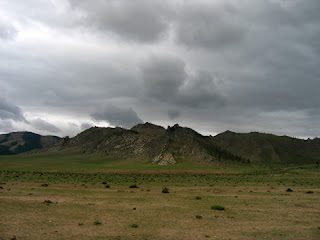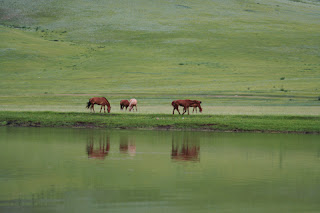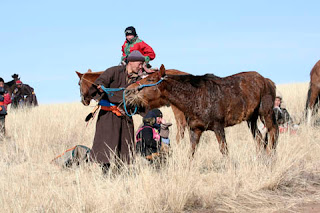
Monday, February 26, 2007
Friday, February 16, 2007
Shri Devi

Shri Devi, the only female wrathful deity among the Dharmapalas, the main deity of Gelugpa Sect, and the protector of Buddhism, is depicted with a dark blue body. She is seated sideways on her mule, with her knees spread apart.
In her right hand, she holds a club with a vajra on the end, and in her left hand, she holds a blood filled skull cup. The mule has two eyes on its hips, one on each side. The flayed skin of a human with its head attached acts as a saddle blanket. The mule stands upon a base consisting of sharply pointed mountains surrounding an ocean of blood.
Her two attendants, walk beside the mule. Makaravaktra dakini, with an elephant head, is on the right holding the mule’s bridle. Simhavaktra dakini, with a lion head, is on the left holding a chopper and a rope noose. In the upper center, Tsongkapa is accompanied by Green Tara in his left and Ushnishavijava in his right. On the right, wrathful Yamantaka and on the left, Vajrapani are in the clouds. In the lower center, Mahakala sits on a lotus base. White Mahakala and Vaishravana are in the lower left and right corners. Lovely scenes of landscape, clouds, and stream are on the left and right sides of the painting.
Mongolians believe that Shri Devi helps to overcome obstacles, to prevent from deceases and to prolong life.
In 17-19th century, although the majority of Mongolian thangkas are painted on a white ground, there are examples with red and black grounds with gold paint, which is called Nagthang. Paintings with red and gold backgrounds depict peaceful deities, while black grounds are reserved for wrathful deities. Gold is used for line work in both red and black thangkas.
Shri-Devi rides on her mule in an ocean of blood surrounded by mountains. She has three glaring eyes, carries a skull cup containing blood in her left hand, and holds a club with a skull-topped and a vajra on the end. Her hair is upswept, she wears a five-skull crown, ring-shaped earrings, jewelries, a rosary of freshly severed heads and a tiger-skin skirt. A wooden stick wrapped in a snake is on her left waist, and a human skull on her right knee’s depiction is very unusual. Her two attendants walk beside the mule. An elephant-headed Makaravaktra dakini is holding the mule’s snake-bridle in the right side, a lion-headed Simhavaktra dakini is holding a skull-cup and a chopper in the left.
Photographer: Gansukh.N, Source: Mongolian Antique Museum
Wednesday, February 14, 2007
Algae

Location: Khyargas lake, Uvs aimag
Need an image for a project or frameable prints? Follow this link or Mongolian Photo
Algae
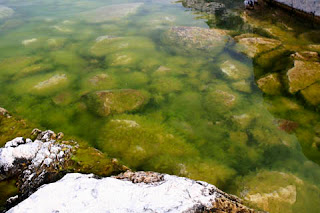
Location: Khyargas lake, Uvs aimag
Need an image for a project or frameable prints? Follow this link or Mongolian Photo
Algae

Location: Khyargas lake, Uvs aimag
Need an image for a project or frameable prints? Follow this link or Mongolian Photo
Algae
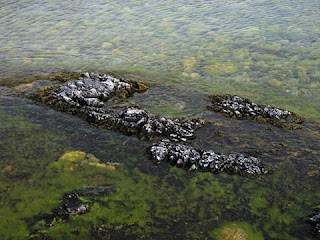
Location: Khyargas lake, Uvs aimag
Need an image for a project or frameable prints? Follow this link or Mongolian Photo
Khyargas lake

Location: Khyargas lake, Uvs aimag
Need an image for a project or frameable prints? Follow this link or Mongolian Photo
Breakfast

Location: Chuluut river, Arkhangai aimag
Need an image for a project or frameable prints? Follow this link or Mongolian Photo
Ice, Yolyn am, South Gobi

Location: Yolyn am, Umnugobi aimag
Need an image for a project or frameable prints? Follow this link or Mongolian Photo
Yolyn am

Location: Yolyn am, Umnugobi aimag
Need an image for a project or frameable prints? Follow this link or Mongolian Photo
Friday, February 9, 2007
Monday, February 5, 2007
Mammal checklist of Mongolia
Insectivora (Insect-Eaters)
Erinaceidae (Hedgehogs, Moonrats)- Hemiechinus dauricus (Daurian Hedgehogs)
- Hemiechinus auritus (Long-eared or desert Hedgehogs)
- Talpa altaica (Siberian mole)
- Sorex daphaenodon (Long toothed shrew)
- Sorex vir (Flat-skulled shrew)
- Sorex caecutiens (Laxman's shrew)
- Sorex minutissimus (Least or Siberian shrew)
- Sorex tundrensis (Borel shrew)
- Sorex araneus (English or Eurasian common shrew)
- Sorex isodon (East-Siberian shrew)
- Sorex minutus (Lesser shrew)
- Neomys fodiens (water shrew)
- Crocidura suaveolens (Scilly shrew)
Chiroptera (Bats)
Vespertilionidae (Vesper bats)- Myotis daubentoni (Daubenton's bat)
- Myotis mystacinus (Whiskered bat)
- Myotis brandtii (Brandt's bat)
- Plecotus auritus (Common bat)
- Plecotus austriacus (Grey long-eared bat)
- Nyctalus noctula (Great bat)
- Vespertilio superans (Eastern bat)
- Vespertilio murinus (Red bat)
- Pipistrellus savii (Savi's pipistrelle)
- Eptesicus nilssoni (Northern bat)
- Eptesicus gobiensis (Gobi-desert bat)
- Eptesicus serotinus (Rattlemouse)
Lagomorpha (Rabbits)
Ochotonidae (Rock conies, whistling hares)- Ochotona hyperborea (Northern pica)
- Ochotona daurica (Daurian pica)
- Ochotona pallasi (Pallas' pica)
- Ochotona alpina (Altai pica)
Leporidae (Hares and rabbits)
- Lepus tolai (Tolai hare)
- Lepus timidus (Mountain hare)
Rodentia (Rodents)
Sciuridae (Squirrels)- Sciurus vulgaris (Brown squirrel)
- Tamias sibiricus (Sibirian chipmunk)
- Marmota baibacina (Altai marmot)
- Marmota sibirica (Sibirian marmot)
- Citellus undulatus (Long-tailed suslik)
- Citellus dauricus (Daurian suslik)
- Citellus pallidicauda (Gobi suslik)
- Citellus erythrogenus (red-cheeked suslik)
- Citellus alaschanicus (Alashan suslik)
Pteromyidae (Flying squirrels)
- Pteromys volans (Flying squirrel)
Castoridae (Beavers)
- Castor fiber (Eurasian beaver)
Cricetidae (Hamsters)
- Phodopus campbell (dwarf hamster)
- Phodopus robolrovskii (Roborowsky's dwarf hamster)
- Cricetulus barabensis (Striped hamster)
- Cricetulus pseudogriseus (Transbaikal hamster)
- Cricetulus sokolovi (Sokolov's hamster)
- Cricetulus obscurus (Gobi hamster)
- Cricetulus longicaudatus (Long-tailed hamster)
- Cricetulus migratorius (Grey hamster)
- Allocricetulus curtatus (Mongolian hamster)
- Myospalax aspalax (Daurian zokor)
- Myospalax psilurus (Manchurian zokor)
- Ellobius orientalis (Oriental mole-vole)
- Ellobius tancrei (Mole lemming)
- Ondatra zibethicus (Muskrat)
- Alticola argentatus (Royle's mountain vole)
- Alticola macrotis (Large-eared vole)
- Alticola barakshin (Gobi-altai mountain vole)
- Alticola strelzovi (Flat-headed vole)
- Clethrionomys rufocanus (Grey sided vole)
- Clethrionomus rutilus (Northern red-backed mouse)
- Lagurus lagurus (Steppe lemming)
- Eolagurus luteus (Yellow steppe lemming)
- Eolagurus przewalskii (Przewalski's lemming)
- Myopus schisticolor (Wood lemming)
- Arvicola terrestris (Ground vole)
- Microtus gregalis (Narrow-sculled vole)
- Microtus fortis (Reed vole)
- Microtus maximowiczii (Maximovich's vole)
- Microtus limmophilus (Meadow vole)
- Microtus oeconomus (Root vole)
- Microtus mongolicus (Mongolian vole)
- Microtus arvalis (Common vole)
- Microtus agrestis (Short-tailed vole)
- Lasiopodomys brandtii (Brandt's vole)
- Lasiopodomys mandarinus (Mandarin vole)
- Meriones tamariscinus (Tamarisk gerbil)
- Meriones unguiculatus (Mongolian gerbil)
- Meriones meridianus (Midday gerbil)
- Rhombomys opimus (Great gerbil)
- Micromys minutus (Harvest mouse)
- Apodemus agrarius (Striped field mouse)
- Apodemus peninsulae (Korean field mouse)
- Rattus norvegicus (Norway rat)
- Mus musculus (House mouse)
- Dryomys nitedula (Forest dormouse)
- Sicista subtilis (Souther birch mouse)
- Allactaga sibirica (Siberian jerboa)
- Allactaga bullata (Gobi jerboa)
- Allactaga elater (Little jerboa)
- Allactaga balicunica (South Gobi jerboa)
- Pygerethmus pumilio (Little earth hare)
- Stylodipus andrewsi (Mongolian jerboa)
- Stylodipus sungorus (Zungarian jerboa)
- Dipus sagitta (Hairy-footed jerboa)
- Dipus halli (Three-toed Jerboa)
- Cardiocranius paradoxus (Satunin's jerboa)
- Salpingotus kozlovi (Kozlov's pygmy jerboa)
- Salpingotus crassicauda (Thick-tailed pygmy jerboa)
- Euchoreutes naso (Long-eared jerboa)
Carnivora (Carnivores)
Canidae (Canids, dogs)- Canis lupus (Grey wolf)
- Vulpes vulpes (Common fox)
- Vulpes corsac (Corsac fox)
- Vulpes ferrilata (Tibetan fox)
- Cuon alpinus (red dog)
- Nyctereutes procyonoides (Raccoon dog)
- Upsus arctos (Brown bear)
- Upsus gobiensis (Gobi bear)
- Martes zibellina (Sable)
- Martes foina (Beech marten)
- Gulo gulo (Wolverine)
- Mustela sibirica (Siberian weasel)
- Mustela altaica (Alpine weasel)
- Mustela erminea (Common weasel)
- Mustela nivalis (Least weasel)
- Mustela eversmanni (Eversmann's polecat)
- Mustela vison (Mink)
- Vormela peregusna (Marbled polecat)
- Meles meles (Badger)
- Lutra lutra (Common otter)
- Uncia uncia (Snow leopard)
- Felis lynx (Lynx)
- Felis manul (Manul cat)
- Felis lybica (wild cat)
Perissodactyla (Odd-toed mammals)
Equidae (Horses)
- Equus przewalskii (Przewalskii wild horse)
- Equus hemionus (Asiatic wild ass)
- Camelus bactrianus ferus (Bactrian wild camel)
Artiodactyla (Artiodactyles)
Suidae (pigs)
- Sus scrofa (Wild boar)
- Moschus moschiferus (Musk-deer)
- Cervus elaphus (Red deer)
- Capreolus pygargus (Roe deer)
- Alces alces (Mooses)
- Rangifer tarandus (Reindeer)
- Gazella subgutturosa (Goitred gazella)
- Procapra gutturosa (Mongolian gazella)
- Saiga tatarica (Antilope)
- Capra sibirica (Siberian ibex)
- Ovis ammon (Wild sheep)

